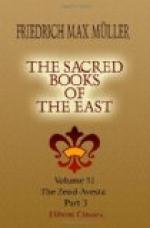[Footnote 88: This is to be understood of fish that live altogether in the sea, and not of those that live in the sea and on land both, as crabs. The Turks, who are Hanifites, never eat this sort of fish; but the sect of Malec Ebn Ans, and perhaps some others, make no scruple of it.]
[Footnote 89: These were the names given by the pagan Arabs to certain camels or sheep which were turned loose to feed, and exempted from common services, in some particular cases; having their ears slit, or some other mark, that they might be known; and this they did in honor of their gods. Which superstitions are here declared to be no ordinances of God, but the inventions of foolish men.]
[Footnote 90: This miracle is thus related by the commentators: Jesus having, at the request of his followers, asked it of God, a red table immediately descended, in their sight, between two clouds, and was set before them; whereupon he rose up, and having made the ablution, prayed, and then took off the cloth which covered the table, saying, “In the name of God, the best provider of food.”]
LIFE OF BUDDHA
BY ASVAGHOSHA BODHISATTVA
Translated from Sanscrit into Chinese by Dharmaraksha,
A.D. 420; from Chinese into English by Samuel Beal
INTRODUCTION
Buddha is undoubtedly the most potent name as a religious teacher, in the whole of Asia. The propaganda of the Buddhistic faith passed from the valley of the Indus to the valley of the Ganges, and from Ceylon to the Himalayas; thence it traversed China, and its conquests seem to have been permanent. The religion of Buddha is so far different from that of Confucius, and so far resembles Christianity, that it combines mysticism with asceticism—a practical rule of personal conduct with a consistent transcendentalism. It has, moreover, the great advantage of possessing a highly fascinating and romantic gospel, or biography, of its founder. Gautama, as the hero of Arnold’s “Light of Asia,” is very well known to English readers, and, although Sir Edwin Arnold is not by any means a poet of the first order, he has done a great deal to familiarize the Anglo-Saxon mind with Oriental life and thought. A far more faithful life of Buddha is that written some time in the first century of our era by the twelfth Buddhist patriarch Asvaghosha. This learned ecclesiastic appears to have travelled about through different districts of India, patiently collecting the stories and traditions which related to the life of his master. These he wove into a Sanscrit poem, which three hundred years later was translated into Chinese, from which version our present translation is made. There can be no doubt that the author of the Sanscrit poem was a famous preacher and musician. Originally living in central India, he seems to have wandered far and wide exercising his office, and reciting or




